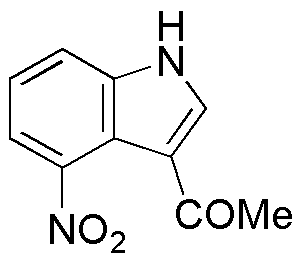3-Acetyl-4-nitroindole is widely utilized in research focused on:
- Pharmaceutical Development: This compound serves as a key intermediate in the synthesis of various pharmaceuticals, particularly in creating anti-inflammatory and analgesic agents.
- Organic Synthesis: It is employed in organic chemistry for the development of novel indole derivatives, which are important in medicinal chemistry due to their diverse biological activities.
- Biological Research: Researchers use it to study the mechanisms of action of nitroindole derivatives, which can lead to the discovery of new therapeutic agents targeting specific diseases.
- Material Science: The compound is explored for its potential applications in developing organic electronic materials, such as organic light-emitting diodes (OLEDs), due to its unique electronic properties.
- Analytical Chemistry: It is utilized as a reference standard in analytical methods, aiding in the detection and quantification of similar compounds in complex mixtures.
General Information
Properties
Safety and Regulations
Applications
3-Acetyl-4-nitroindole is widely utilized in research focused on:
- Pharmaceutical Development: This compound serves as a key intermediate in the synthesis of various pharmaceuticals, particularly in creating anti-inflammatory and analgesic agents.
- Organic Synthesis: It is employed in organic chemistry for the development of novel indole derivatives, which are important in medicinal chemistry due to their diverse biological activities.
- Biological Research: Researchers use it to study the mechanisms of action of nitroindole derivatives, which can lead to the discovery of new therapeutic agents targeting specific diseases.
- Material Science: The compound is explored for its potential applications in developing organic electronic materials, such as organic light-emitting diodes (OLEDs), due to its unique electronic properties.
- Analytical Chemistry: It is utilized as a reference standard in analytical methods, aiding in the detection and quantification of similar compounds in complex mixtures.
Documents
Safety Data Sheets (SDS)
The SDS provides comprehensive safety information on handling, storage, and disposal of the product.
Product Specification (PS)
The PS provides a comprehensive breakdown of the product’s properties, including chemical composition, physical state, purity, and storage requirements. It also details acceptable quality ranges and the product's intended applications.
Certificates of Analysis (COA)
Search for Certificates of Analysis (COA) by entering the products Lot Number. Lot and Batch Numbers can be found on a product’s label following the words ‘Lot’ or ‘Batch’.
*Catalog Number
*Lot Number
Certificates Of Origin (COO)
This COO confirms the country where the product was manufactured, and also details the materials and components used in it and whether it is derived from natural, synthetic, or other specific sources. This certificate may be required for customs, trade, and regulatory compliance.
*Catalog Number
*Lot Number
Safety Data Sheets (SDS)
The SDS provides comprehensive safety information on handling, storage, and disposal of the product.
DownloadProduct Specification (PS)
The PS provides a comprehensive breakdown of the product’s properties, including chemical composition, physical state, purity, and storage requirements. It also details acceptable quality ranges and the product's intended applications.
DownloadCertificates of Analysis (COA)
Search for Certificates of Analysis (COA) by entering the products Lot Number. Lot and Batch Numbers can be found on a product’s label following the words ‘Lot’ or ‘Batch’.
*Catalog Number
*Lot Number
Certificates Of Origin (COO)
This COO confirms the country where the product was manufactured, and also details the materials and components used in it and whether it is derived from natural, synthetic, or other specific sources. This certificate may be required for customs, trade, and regulatory compliance.


